Understanding Renal Cell Carcinoma Metastasis to the Lung


Intro
Renal cell carcinoma (RCC) is not just another item on the cancer check-list; it stands as a formidable challenge within the oncology realm, particularly owing to its tendency to metastasize. Among the various sites for metastasis, the lungs bear the brunt, making it crucial to understand the whirlpool of mechanisms that facilitate this aggressive behavior.
Diving into the conundrums of RCC metastasis, it’s important to grasp why the lung becomes a preferred destination. It’s not just about random chance; rather, it reflects complex biological pathways and interactions. The intricacies lie in how RCC cells escape the primary tumor site, travel through the bloodstream, and invade lung tissues. This journey affects not only patient outcomes but also opens doors for potential treatment strategies, which warrants a keen examination of the subject.
The conversation surrounding RCC lung metastasis is seldom straightforward. Diagnostic challenges persist, often leaving healthcare providers grappling with timely identification of the condition. Through this analysis, we will unravel the biological mechanisms at play while exploring clinical implications that arise from the metastatic process. In the end, a clear picture emerges, not just of what RCC does, but how practitioners and researchers can respond in meaningful ways.
Preamble to Renal Cell Carcinoma
Renal cell carcinoma, often abbreviated as RCC, has become a focal point in oncology research due to its increasing incidence and mortality rates. The significance of understanding renal cell carcinoma cannot be overstated. It is crucial for students, researchers, and healthcare providers alike. This article delves into various elements surrounding RCC, particularly focusing on its metastasis to the lungs.
Definition and Epidemiology
Renal cell carcinoma is a malignancy arising from the renal tubules in the kidneys. It is the most common type of kidney cancer in adults, accounting for approximately 90% of cases. Notably, RCC can present in many forms, with clear cell carcinoma being the most prevalent variant. The epidemiology highlights that RCC's incidence varies across different geographical regions and populations, influenced by factors such as age, gender, and ethnicity. For instance, men have a nearly double risk of developing RCC compared to women, likely due to lifestyle factors and biological differences.
Statistical data reveals that in the United States alone, about 76,000 new cases were anticipated in 2019, with mortality rates hounding roughly 13,000 individuals. This upward trend is alarming, emphasizing the need for increased awareness and early detection.
Histological Classification
Histological classification plays a vital role in the diagnosis and management of renal cell carcinoma. The World Health Organization classifies RCC into several distinct types based on the appearance of the cells under microscopic examination. The primary subclasses include:
- Clear Cell Carcinoma: Characterized by its clear, glycogen-rich cytoplasm, this type represents the majority of renal cell carcinoma cases.
- Papillary Carcinoma: Accounts for about 10% of RCC cases; it possesses finger-like projections and can be classified into type 1 and type 2 based on certain genetic mutations.
- Chromophobe Carcinoma: Generally considered to have a better prognosis than clear cell, it displays a distinct cellular morphology without the clear cytoplasm.
- Collecting Duct Carcinoma: A rare and aggressive form that arises from the collecting ducts within the kidney.
Knowing the histological subtypes provides insights not only for diagnosis but also for tailored therapeutic approaches. It influences decisions regarding targeted therapies and prognostic predictions, which can ultimately impact patient outcomes.
Risk Factors
Identifying risk factors associated with renal cell carcinoma is essential for developing preventive strategies. Various lifestyle and environmental factors contribute to the likelihood of developing RCC. Key risk factors include:
- Smoking: Tobacco use has been confirmed as a significant risk factor, increasing the likelihood of developing RCC.
- Obesity: Being overweight contributes to hormonal changes that may encourage cancer development.
- Hypertension: High blood pressure and the medications used to treat it can also be linked to a heightened risk of RCC.
- Family History: Genetic predisposition plays a role, with certain inherited conditions like von Hippel-Lindau disease and hereditary leiomyomatosis increasing risk.
- Occupational Exposures: Exposure to certain chemicals, like asbestos and trichloroethylene, has also been implicated in RCC development.
Understanding these risk factors is crucial for early diagnosis and encourages proactive measures in high-risk populations. The complexities of RCC demand a multidisciplinary approach to education, prevention, and treatment.
Metastasis: An Overview
Metastasis serves as a pivotal concept in understanding how renal cell carcinoma (RCC) progresses and ultimately affects patient outcomes. The ability of cancer cells to spread from their primary site to distant organs, such as the lungs, underscores the grave nature of this disease. By grasping the essence of metastasis, both clinicians and researchers can identify more effective strategies to lessen the burden of RCC on patients.
Importance of Metastasis in RCC
The proliferation of renal cell carcinoma cells into the lungs illuminates various aspects relevant to treatment and management.
- Pathophysiological Insights: Understanding the mechanisms that propel metastasis to the lungs can pinpoint potential therapeutic targets. For instance, researchers are keen to explore signaling pathways that enable neoplastic cells to invade lung tissue.
- Clinical Implications: Early identification of lung metastases can significantly enhance treatment outcomes. Patients who receive timely intervention may experience improved quality of life and survival rates.
- Diagnostic Challenges: The symptoms of lung metastasis can mimic other pulmonary conditions, complicating the diagnostic process. Gaining insight into the variations in presentation is integral for making accurate diagnoses, which directly impacts management strategies.
These elements blend together to highlight why a thorough comprehension of metastasis in RCC can improve clinical practices and optimize patient care.
"A cancer diagnosis is not merely about the disease itself, but encompasses a spectrum of biological pathways that dictate its behavior."
Biological Mechanisms of Metastasis
The journey of renal cancer cells from the kidneys to the lung involves a complex interplay of biological processes. Tumor cells can detach from the primary tumor and exhibit a capacity for migration through various mechanisms, such as:
- Cell Adhesion Molecules: These proteins play critical roles in the metastatic spread by regulating cell-to-cell interactions. Alterations in expression can enable cancer cells to detach from original sites and infiltrate new tissues, including the lungs.
- Epithelial-Mesenchymal Transition (EMT): This process allows carcinoma cells to acquire migratory and invasive properties. In RCC, EMT facilitates the escape of cells into circulation and subsequent colonization of secondary sites.
- Angiogenesis: The formation of new blood vessels is essential for providing nutrients and a conducive environment for proliferating cancer cells at distant sites.
Investigating these mechanisms not only informs clinical strategies but also provides avenues for targeted therapies that could disrupt the metastatic process.
Common Sites of Metastasis
In RCC, the lungs stand out as a frequent site for metastasis, alongside others such as the liver and bones. The preference of renal tumors for the lung can be attributed to several factors:
- Vascular Connectivity: The rich blood supply to the lungs offers a nurturing environment for cancer cells that have entered the bloodstream.
- Tumor Microenvironment: The lung tissue can create favorable conditions for metastasis, enabling cancer cell survival and growth after dissemination.
- Cellular Traits: Specific genomic alterations often present in RCC enable a stronger affinity for lung tissue compared to other organs.
Understanding the common metastatic sites helps identify patients at higher risk and assists in tailoring screening and therapeutic endeavors accordingly.
By examining the landscape of metastasis in renal cell carcinoma comprehensively, one can appreciate the intricacies involved in managing the disease effectively. This knowledge not only illuminates future research directions but also empowers healthcare providers to approach RCC with an informed mindset.
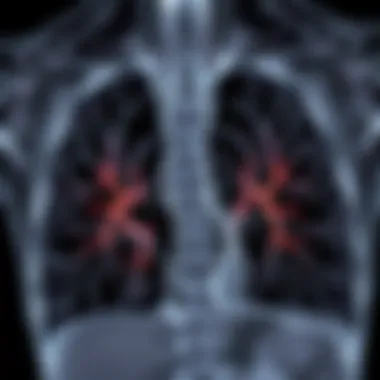
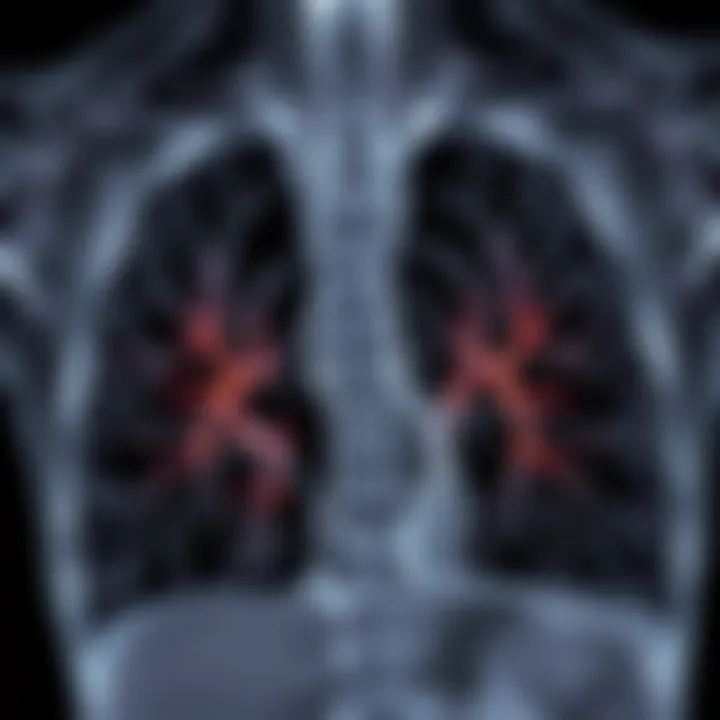
Metastatic Pathways in RCC
Renal cell carcinoma's invasive characteristics can be observed through its distinct pathways of metastasis, crucial for understanding its progression and treatment. By elucidating these pathways—specifically hematogenous spread and lymphatic involvement—the article aims to shed light on the biological mechanics that facilitate RCC's reach to the lungs. This exploration is vital, as the targeted approach to metastasis can significantly influence patient management strategies and therapeutic outcomes. Understanding how cancer cells journey through the body enables oncologists to develop more focused treatment modalities and assess patients' prognoses more accurately.
Hematogenous Spread
Hematogenous spread represents a key route that renal cell carcinoma takes to establish lung metastases. In essence, this pathway involves the dissemination of cancer cells through the bloodstream. Once RCC cells gain access to the vascular system, they can travel to various organs, including the lungs. The importance of this mechanism lies not only in its frequency but also in the unique challenges it presents for early detection and treatment.
The process begins when RCC tumors penetrate into local blood vessels, which can be attributed to several factors, including the breakdown of surrounding tissue or the presence of growth factors that promote angiogenesis. Upon entering the circulation, malignant cells must survive various immune defenses designed to eliminate rogue cells. Those that successfully evade such defenses often cluster in capillary beds, particularly in organs with high blood flow, like the lungs.
In clinical settings, identifying hematogenous metastases requires vigilance, as symptoms might be subtle initially. Common signs related to lung involvement can include persistent cough and unusual discomfort, which often leads to misinterpretation as benign conditions. Advanced imaging techniques like PET scans and CT angiography can help in accurately locating metastases that have taken the hematogenous route.
Lymphatic Involvement
Lymphatic involvement represents another significant pathway for metastasis in renal cell carcinoma, functioning quite differently from hematogenous spread. The lymphatic system, tasked with immune response and fluid regulation, offers a route that often allows RCC to metastasize before becoming evident in blood circulation. This pathway primarily facilitates the movement of cancer cells to regional lymph nodes, which can then spread to distant sites, including the lungs.
In this process, RCC cells may first invade nearby lymphatic vessels adjacent to the primary renal tumor. The interconnected nature of the lymphatic system can create a rapid transport network for malignant cells. Understanding this dynamics emphasizes the necessity of closely monitoring lymph nodes during diagnosis and treatment phases because they can serve as critical indicators of the disease's stage. Involvement of lymph nodes may predict later metastasis to the lungs, so removing or examining these nodes can provide pivotal insights for clinical outcomes.
The lymphatic route often allows RCC to infiltrate distant organs more insidiously, complicating effective management strategies.
Clinically, lymphatic spread can manifest in various ways, including swelling and discomfort in the axillary or groin regions, depending on affected lymph nodes. Advanced diagnostic techniques, such as sentinel lymph node biopsy, become increasingly relevant in staging and planning appropriate treatment protocols. These assessments prove essential for understanding the broader implications of RCC on patient health and survival.
By examining both hematogenous spread and lymphatic involvement, a comprehensive picture of renal cell carcinoma metastasis emerges. Each path enables the cancer to infiltrate lung tissues and necessitates tailored strategies for monitoring and treating the disease effectively.
Clinical Manifestations of Lung Metastases
Understanding the clinical manifestations of lung metastases in renal cell carcinoma (RCC) is pivotal for timely diagnosis and effective management of this aggressive disease. The lung is one of the most common metastatic sites for RCC, and the way it presents can vary significantly among patients. Recognizing these manifestations allows for prompt intervention, which can greatly influence patient outcomes.
Symptoms and Diagnosis
Patients with lung metastases can exhibit a range of symptoms that often overlap with other pulmonary conditions. Some common symptoms include:
- Persistent Cough: Many patients report a cough that does not respond to typical treatments. This can often be the first clue pointing towards lung involvement.
- Shortness of Breath: Known as dyspnea, this symptom might arise from the presence of tumors impairing lung function or from fluid accumulation within the pleural space.
- Chest Pain: Pleuritic chest pain is frequently reported, particularly if the metastasis causes irritation of the pleura.
- Hemoptysis: Coughing up blood, while less common, can alarm both patients and doctors, requiring further investigation.
Patients must undergo thorough diagnostic evaluations that typically include imaging tests such as chest X-rays, CT scans, or MRIs. These tools not only help visualize lung lesions but also assess their size and extent. Often, the diagnosis might be confirmed through tissue biopsies, either by bronchoscopy or needle aspiration.
"Early detection of symptoms significantly improves the chances for better treatment outcomes."
Finally, it’s important for healthcare providers to differentiate between RCC lung metastases and other pulmonary conditions such as infections, as management strategies will differ markedly. This accuracy underscores the significance of a comprehensive approach to diagnosis.
Radiological Findings
Radiological imaging plays a crucial role in identifying and evaluating lung metastases from renal cell carcinoma. Typical findings on imaging may include:
- Nodules or masses: CT scans often reveal well-defined round nodules which can vary in size. These may be solitary or multiple.
- Lung Opacity: Areas of increased radiological density might suggest the presence of lesions.
- Pleural Effusions: Fluid around the lungs can be indicative of advanced metastatic disease and might necessitate further investigation.
- Lymphadenopathy: Enlarged lymph nodes, particularly around the mediastinum or hilum, can be a sign of widespread disease.
Radiological findings often help in staging the disease and inform treatment strategies. Interpretation of these images requires experienced radiologists familiar with the nuances of RCC metastasis.
Treatment Options for RCC with Lung Metastasis
The management of renal cell carcinoma (RCC) with lung metastasis poses unique challenges and requires a multifaceted approach. As RCC is notorious for its aggressive nature and potential for metastasis, treatment strategies must be tailored to meet the specific needs of each patient. Understanding these treatment options is crucial in improving patient outcomes and navigating the complexities associated with this condition.
Surgical Intervention
Surgical options for patients with RCC that has metastasized to the lung can offer the best chance for long-term survival, particularly in selected patients. Resection of lung metastases can be beneficial if isolated and if the primary tumor has been controlled. Recently, the role of surgery has expanded to include patients with limited metastatic burden. Factors that influence the candidacy for surgical intervention include the number of metastatic lesions, their size, and the overall health of the patient.
Benefits of surgical intervention include:
- Potential for cure: In cases where metastasis is confined, complete resection might eliminate the cancer altogether.
- Symptomatic relief: Many patients experience an improvement in quality of life following surgery, as lung resection can alleviate respiratory symptoms caused by metastases.
Despite these benefits, surgery is not without risks, including potential complications from the procedure itself and the challenge of managing recurrences. Therefore, a careful assessment by a multidisciplinary team is essential in determining the appropriateness of surgical intervention.
Systemic Therapies
Systemic therapy plays a critical role when it comes to treating RCC with lung metastasis, especially when the disease is widespread or when surgery is not feasible. The evolution of systemic treatments has ushered in new classes of drugs aimed at addressing the underlying biology of RCC. These therapies primarily include targeted therapies and immuno-oncology agents.
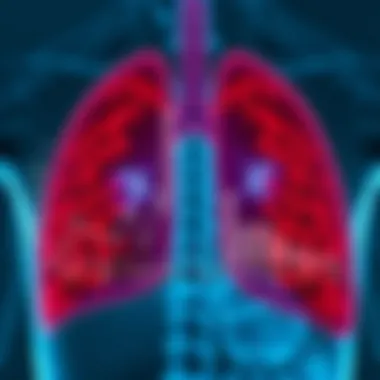

The primary objectives of systemic therapies include:
- Controlling disease progression: This aims to shrink tumors, stabilize disease, and potentially prolong survival.
- Managing symptoms: Effective systemic therapy can help alleviate symptoms associated with metastatic disease.
Despite advancements in systemic therapies, challenges remain; response rates can vary significantly among patients, and many may experience treatment-related adverse effects that impact their overall quality of life. Furthermore, the use of systemic therapies often requires ongoing monitoring to evaluate efficacy and manage potential complications.
Targeted Therapy and Immunotherapy
In recent years, targeted therapy and immunotherapy have emerged as cornerstone approaches in the management of RCC. Targeted therapies, such as sunitinib, pazopanib, and axitinib, specifically aim at the vascular endothelial growth factor (VEGF) pathway, inhibiting tumor angiogenesis. This approach effectively starves the tumors of necessary nutrients and oxygen, leading to slower growth or tumor regression.
On the other hand, immunotherapy harnesses the power of the immune system to combat cancer cells. Agents like nivolumab and pembrolizumab have shown promise in improving overall survival rates by enhancing the body’s immune response against tumors. The trend is shifting toward combination therapies, where the strengths of both targeted therapy and immunotherapy can be utilized to maximize efficacy.
Some considerations regarding these therapies include:
- Individualized treatment plans: Genetic profiling and biomarkers can guide clinicians in selecting the most appropriate therapy.
- Potential for immune-related adverse events: Particularly with immunotherapy, patients may experience unexpected side effects that require management.
The realm of targeted therapy and immunotherapy is continually evolving, with ongoing clinical trials aimed at discovering new agents and combinations.
In sum, the landscape of treatment options for RCC with lung metastasis is diverse and ever-evolving. From surgical interventions to advanced systemic therapies, each option carries its own set of benefits and challenges. A multidisciplinary approach is essential in optimizing outcomes, ensuring that patients receive personalized care tailored to their specific needs.
Prognosis and Survival Rates
Prognosis and survival rates play a critical role in the conversation surrounding renal cell carcinoma (RCC) and its lung metastasis. Understanding these rates can significantly influence treatment decisions, patient counseling, and overall management strategies. This section dives into how the prognosis of RCC patients, particularly those with lung involvement, can be shaped by various factors, many of which merit a closer inspection.
Staging and Grading of RCC
Staging and grading provide the backbone of predicting outcomes in RCC. The staging process assesses the tumor's extent, categorizing it based on size and the presence of metastases. The most recognized system for this is the AJCC (American Joint Committee on Cancer) staging system, which categorizes tumors on a scale from I to IV:
- Stage I: Tumor confined to the kidney, small in size.
- Stage II: Larger tumor, still within the kidney but may affect nearby fat.
- Stage III: Tumor spread to nearby lymph nodes or blood vessels.
- Stage IV: Distant metastasis, including lung spread.
Within these categories, grading refers to how abnormal the cancer cells look under a microscope, with higher grades indicating more aggressive cancer behavior. High-grade tumors often correlate with poorer outcomes. Both staging and grading are pivotal in estimating survival rates and strategizing treatment.
Factors Influencing Prognosis
Several factors can tip the scales in favor of improved or worsened prognosis for RCC patients with lung metastasis:
- Performance Status: A patient’s overall health can heavily influence survival. Better performance status typically translates to better outcomes.
- Histological Type: Different variants of RCC, such as clear-cell carcinoma versus papillary carcinoma, may possess distinct prognostic implications.
- Presence of Symptoms: Symptomatology at the time of diagnosis, such as weight loss and bone pain, can provide clues regarding disease aggressiveness and likelihood of successful treatment outcomes.
- Metastatic Burden: The number and extent of lung metastases (uni versus multi-focal) may significantly impact survival; patients with solitary metastases might fare better than those with widespread involvement.
- Response to Initial Treatment: How well a patient responds to initial therapies, whether surgical or systemic, can also be predictive of overall prognosis and survival.
The intricacies of RCC prognosis encompass a myriad of factors. It is insightful for healthcare providers to weigh these elements when discussing outcomes with patients.
Research continues to refine our understanding of these factors, emphasizing the importance of a personalized approach in managing renal cell carcinoma. The interplay between these elements profoundly influences not just survival rates, but quality of life as well, making it an essential area of exploration in oncology. For those involved in the care and management of RCC, staying abreast of the latest findings in prognostic indicators will enhance their ability to tailor treatment effectively.
For further insights, consider exploring resources from National Cancer Institute, American Cancer Society, and PubMed, which provide comprehensive data and ongoing research on the subject.
Current Research Trends
Research in renal cell carcinoma (RCC) has become increasingly pivotal, particularly due to the complex nature of its metastasis, especially when involving the lungs. The trends emerging in this area not only enhance our understanding but also pave the way for innovative treatment methods. Staying abreast of current research can profoundly impact patient outcomes and management strategies.
Innovations in Diagnosis
The realm of diagnostics is undergoing remarkable transformations. One notable advancement is the use of liquid biopsy techniques, which allow for the analysis of circulating tumor DNA (ctDNA) found in blood samples. This method is less invasive compared to traditional biopsies and can reveal critical information about tumor mutations and overall genetic profile.
Other innovations include:
- Advanced Imaging Techniques: Modern imaging modalities like PET-CT scans incorporate metabolic activity into visuals, providing a more comprehensive picture of tumor behavior compared to earlier imaging forms.
- Biomarker Identification: Ongoing research aims to discover specific biomarkers that can predict the likelihood of lung metastases. Identifying these markers could lead to earlier interventions and tailored treatment plans.
- Artificial Intelligence: AI algorithms are now being integrated into diagnostic processes, enabling quicker analysis of imaging results and potentially uncovering patterns that human eyes might miss.
These innovations address not just the timeliness of diagnostics but also increase the accuracy, ensuring patients receive the most suitable treatment swiftly.
Emerging Therapies
In the face of RCC with lung metastases, research continues to expand therapeutic horizons. Here are a few emerging therapy avenues:
- Checkpoint Inhibitors: These immunotherapeutic agents work by unmasking cancer cells to the immune system. Agents such as nivolumab and pembrolizumab show promise in enhancing anti-tumor immunity, potentially increasing survival rates among patients with metastatic RCC.
- CAR T-Cell Therapy: This form of treatment involves modifying a patient's T-cells to specifically target cancer cells. Though still in experimental phases for RCC, early findings demonstrate encouraging results.
- Combination Therapies: Research is increasingly supporting the use of combination treatments, such as pairing targeted therapies with traditional chemotherapy or immunotherapy. The synergistic effects of such combinations may lead to more effective management of advanced RCC.
Moreover, the advent of gene therapy is being explored as a future possibility, aiming to correct the underlying genetic mutations driving RCC. Though these treatments are still in the pipeline, their potential makes them worthwhile to monitor.
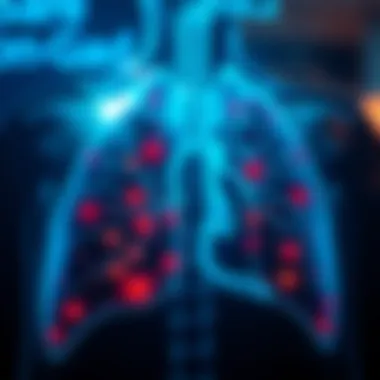
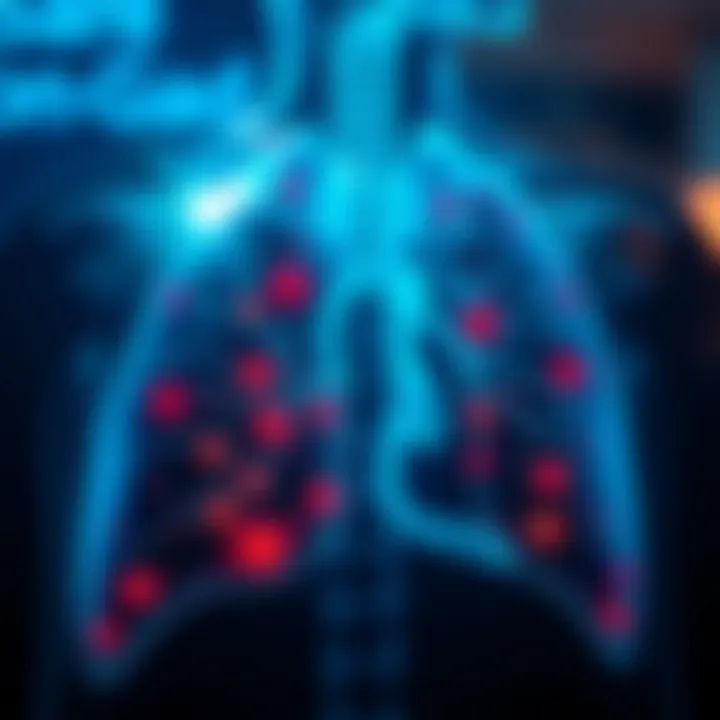
The End
As research continues to flourish in understanding RCC and its propensity to metastasize, innovations in both diagnosis and therapy stand out prominently. These advancements not only foster hope for improved prognosis but also signify a shift towards more personalized treatment strategies, ultimately enhancing the quality of life and survival for those affected.
Multidisciplinary Management of RCC
Managing renal cell carcinoma (RCC) effectively requires a well-coordinated approach that draws on diverse expertise from various healthcare professionals. This multidisciplinary management is crucial not just for improving clinical outcomes, but also for enhancing the overall patient experience. The complexity of RCC, especially when it involves lung metastasis, underscores the need for collaboration among oncologists, surgeons, radiologists, pathologists, and palliative care specialists. This integrated approach enables a comprehensive treatment strategy tailored to individual patient needs, taking into account clinical data, tumor characteristics, and personal preferences.
The Role of Oncology Teams
Oncology teams play a pivotal role in the management of RCC. Typically, these teams consist of medical oncologists, surgical oncologists, radiation oncologists, radiologists, and support staff. Each member brings unique skills to the table:
- Medical Oncologists: They focus on the systemic treatment of RCC, guiding patients through chemotherapy, targeted therapies, and immunotherapies.
- Surgical Oncologists: Their expertise is crucial for any operative interventions, which may be necessary in cases of localized primary tumors.
- Radiologists: They are responsible for imaging studies that assist in diagnosis, treatment planning, and monitoring response to therapy.
- Pathologists: Their analysis of tissue samples informs the histological classification and staging of cancer, which are critical for treatment decisions.
- Support Staff: This includes nurse navigators and social workers who help patients navigate the healthcare system and provide emotional support.
When these professionals work together, they can ensure a cohesive treatment plan that optimally addresses the unique challenges posed by RCC metastasis to the lungs. Regular multidisciplinary team meetings facilitate the sharing of insights and adjustments to treatment protocols based on the latest research findings and clinical experiences.
Palliative Care Considerations
Palliative care is another cornerstone of comprehensive RCC management, particularly for patients with lung metastasis facing advanced disease. This aspect of care focuses not only on alleviating symptoms but also on improving the quality of life for patients and their families. The inclusion of palliative care specialists in the treatment team ensures that patients receive support tailored to their emotional, spiritual, and physical needs.
Key components of palliative care include:
- Pain Management: Tailored interventions to manage pain, which is often a significant issue in advanced cancer.
- Symptom Relief: Addressing symptoms such as dyspnea, fatigue, and anxiety, which can heavily impact patient comfort and wellbeing.
- Patient and Family Support: Providing social and psychological support to both patients and their families, which can include counseling and resources to navigate healthcare decisions.
Importantly, initiating palliative care does not mean the abandonment of curative treatment; rather, it complements it by ensuring that patients maintain the best possible quality of life throughout their treatment journey. This holistic approach is essential, as studies have shown that early integration of palliative care can lead to improved patient satisfaction and may even prolong survival in some cases.
Challenges in Managing Lung Metastases
The management of lung metastases from renal cell carcinoma (RCC) presents multifaceted challenges that are critical to the understanding and treatment of this disease. Doctors often face an uphill battle due to the aggressive nature of RCC and its ability to spread to distant organs, particularly the lungs. The complexity of diagnosing lung metastases, coupled with the inherent resistance to certain treatment modalities, makes this an area that warrants thorough investigation.
Diagnostic Complexities
Detecting lung metastases early is paramount, as timely intervention can markedly affect patient outcomes. However, the diagnostic process is riddled with challenges. The lungs are frequently involved in metastatic spread, and distinguishing between primary pulmonary conditions and metastatic disease can be like finding a needle in a haystack.
The imaging techniques used, such as chest X-rays, CT scans, or PET scans, may not always provide clear differentiation between benign lung nodules and malignant lesions. For instance, some imaging modalities can yield false positives, suggesting malignancy where none exists, while others can miss small or atypical lesions that can easily be mistaken for infections or scars.
Patients often undergo a series of tests before a definitive diagnosis is made. This process can be taxing, both physically and emotionally. Factors like previous histories of lung conditions or smoking can complicate the interpretation of imaging results. Additionally, many RCC patients might present with symptoms like cough or fatigue, which are also common in other pulmonary diseases. Thus, achieving an accurate diagnosis requires a careful and methodical approach, often involving multidisciplinary teams that bring together oncologists, radiologists, and pathologists.
Resistance to Treatment
Once lung metastases are diagnosed, the challenge shifts toward treatment resistance. RCC is known for various aggressive characteristics, which frequently translate into treatment challenges. For traditional therapies, such as chemotherapy, RCC often displays inherent resistance, primarily due to its genetic and epigenetic factors. This means that while conventional chemotherapeutic agents may work against some tumors, they might not have the same effect on RCC.
Moreover, the advent of targeted therapy and immunotherapy has ushered in a new era of treatment options, yet not every patient responds favorably. Tumor heterogeneity plays a significant role in this treatment resistance. For example, variations in genetic mutations across different tumor sites in the same patient can lead to varied responses to treatment. As the tumor evolves, it can exploit alternative pathways to survive, leading to increased tumor aggression and a higher likelihood of treatment failure.
Proactive management strategies are essential. Such strategies may involve identifying biomarkers to predict treatment response or employing combination therapies to tackle resistance head-on. Regular monitoring and adaptability in treatment regimens are crucial to keeping lung metastases in check and improving patient quality of life.
Ultimately, the management of lung metastases from RCC is both a science and an art, necessitating an intricate balance of advanced diagnostics and innovative treatment options to enhance patient outcomes.
Patient Perspectives and Quality of Life
Understanding the impact of renal cell carcinoma (RCC) on patients extends beyond pure medical statistics and treatment outcomes; it delves into the realms of emotional, social, and psychological dimensions of their lives. The quality of life for individuals grappling with lung metastases from RCC is a nuanced experience, shaped by a multitude of factors such as disease progression, treatment responses, and individual resilience. Examining patient perspectives offers crucial insights into their lived experiences and highlights the essential role of support systems in navigating these challenges.
Psychosocial Impacts
Metastatic RCC can wreak havoc on a patient’s psyche, leaving many feeling as if they are drowning in uncertainty. The looming threat of metastatic disease may provoke an array of emotional responses, from anxiety to outright despair. Patients often report feelings of isolation, particularly if their social circles struggle to comprehend the gravity of their condition. This isolation can amplify feelings of helplessness, creating a feedback loop that adversely affects mental health.
Furthermore, the physical symptoms associated with lung metastases, such as persistent cough, fatigue, and breathlessness, can diminish one's quality of life significantly. These symptoms impact daily activities and social engagements, often leading to a withdrawal from previously enjoyed pursuits. When patients experience these psychosocial burdens, it is essential to acknowledge the interplay between mental and physical health.
"The mind is a powerful thing. When you fill it with positive thoughts, your life will start to change." — Unknown
A critical aspect here is the significance of personalized psychological support. Evidence shows that patients who receive mental health care alongside their physical treatment, whether through counseling or support groups, tend to have better quality of life outcomes. Additionally, mindfulness and stress-reduction techniques can arm patients with coping mechanisms to combat the emotional turmoil linked with a cancer diagnosis.
Support Systems
Support systems are vital in cushioning the blows dealt by metastatic RCC. Family, friends, and healthcare providers play pivotal roles in a patient’s journey. Practical assistance—like transportation to appointments or help with household tasks—can alleviate immediate stressors, allowing patients to focus on their health. Emotional support, on the other hand, often manifests through listening, understanding, and offering solace during daunting times.
Moreover, organized peer support groups can cultivate a sense of belonging. These groups—whether in-person or online—allow patients to share experiences, fears, and coping strategies. For many, having a confidant who understands the journey can be like finding a lifeline amidst a stormy sea.
Patients often also benefit from integrating structured programs within their care that address both cancer treatment and holistic wellness. Resources provided by institutions or community organizations can enhance a patient’s experience, offering educational materials on managing symptoms or emotional challenges.
In the realm of self-advocacy, empowering patients to voice their needs and preferences can radically reshape their experiences. Being an active participant in treatment discussions fosters a sense of control, which is often sorely lacking when faced with a diagnosis like RCC.
As the challenges of lung metastasis intermingle with the complex lives of patients, recognizing the importance of psychosocial impacts and robust support systems is paramount, not just for surviving but thriving through the journey of renal cell carcinoma.



